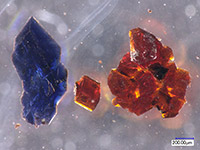A Crystal of a Different Color
One chemical forms two colors of crystals, gives insight into agostic bonds vital in industrial catalysis
(August 2013)

At Pacific Northwest National Laboratory, researchers described the first example of a metal-based catalyst that contains two different agostic bonds. The different forms, which create orange or blue crystals, illuminate the versatility of agostic bonding. This work will help scientists get a better handle on some catalytic reactions found in common industrial processes such as making plastic or fuels. Enlarge Image.
Results: Chemists at Pacific Northwest National Laboratory have unexpectedly made two differently colored crystals -- one orange, the other blue -- from one chemical in the same flask while studying a special kind of molecular connection called an agostic bond. The discovery is providing insights into important industrial chemical reactions such as those that occur while making plastics and fuels.
"We were studying agostic bonds in a project to make liquid fuels like methanol from carbon dioxide to replace fuels we get from oil," said Dr. Morris Bullock, a chemist at PNNL. "We knew the molecule we were making would have an agostic bond, but we had no idea there'd be two flavors of these metal complexes."
While chemists have studied these bonds in chemicals in liquid form, no one had crystallized one chemical with multiple forms of its agostic bonds. And no one expected different forms to give rise to different colors.
Why It Matters: The metal in a catalyst is usually the reactive heart of the molecule. Bullock and postdoctoral chemist Edwin van der Eide knew an agostic bond in their catalyst would help protect the reactive metal from working at the wrong time: The carbon-hydrogen bond blocks the reactive metal until conditions are right, which in turn would help the scientists better control the catalytic reactions to use renewable materials instead of fossil fuels, which present security, environmental and economic issues.
Methods: Van der Eide began with a violet solution of the molybdenum-containing catalyst, he added another liquid to crystallize the molybdenum complex. Crystals formed at the bottom of the flask and others formed near the top.
Oddly, the crystals were two different colors.
Orange crystals formed at the bottom of the flask and blue above. If van der Eide dissolved either the orange or blue crystals in a fresh flask of the original solvent, the violet color returned, with the same properties as the original violet solution. These results suggested that either molecule in the two colored solids could give rise to both structures in liquid, where they easily change back and forth.
The researchers examined the differently colored crystals to determine their structures. The molecule forms a shape like a piano stool: a ringed section forms a stool seat on top of the molybdenum atom, with multiple legs connecting to the molybdenum at the bottom.
One of the legs, however, is longer than the others and contains a chain of three carbon atoms, each with at least one protruding hydrogen. The team found that the long leg was involved in the agostic bonds, with the middle carbon atom involved in the orange crystals and an end carbon involved in the blue crystals.
Ping Yang used EMSL's supercomputer Chinook to perform theoretical calculations on the orange and blue structures. Chemically, the two structures were almost equally likely to form, with the blue one having a slight edge. The analysis also revealed why the crystals were different colors, which is due to subtleties within the structures.
What's Next? This work is part of PNNL's ongoing research into the fundamental questions of catalytic structures and bonding.
Acknowledgments:
Sponsors: U.S. Department of Energy, Office of Basic Energy Sciences, Chemical Sciences, Geosciences and Biosciences Division
User Facility: EMSL
Research Area: Chemical Sciences
Research Team: Edwin F. Van der Eide, Ping Yang, and R. Morris Bullock, PNNL
Reference: van der Eide, EF, P Yang, and RM Bullock. 2013. "Isolation of Two Agostic Isomers of an Organometallic Cation: Different Structures and Colors." Angewandte Chemie International Edition 52(39):10190-10194. DOI: 10.1002/anie.201305032
